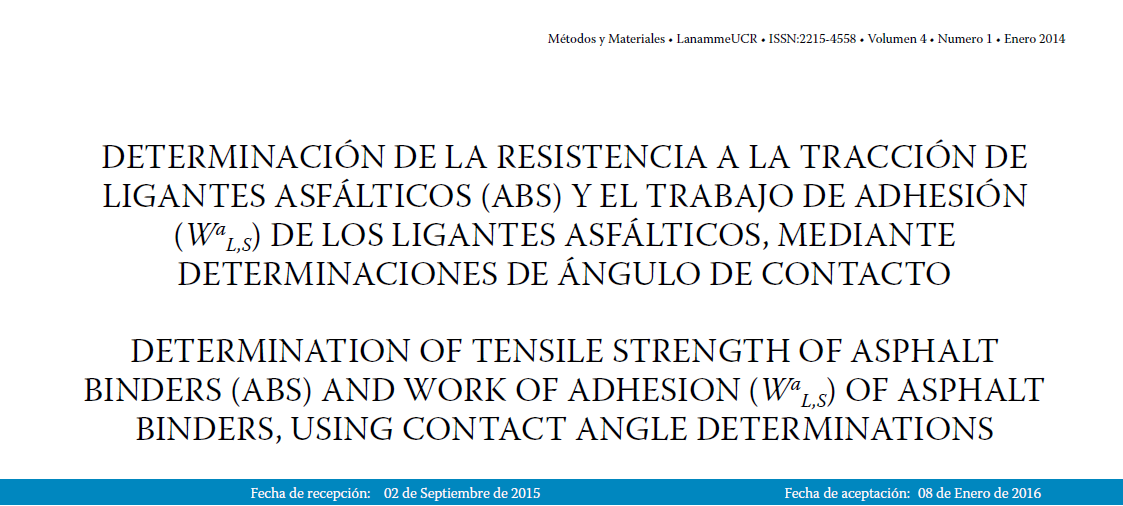Resumen
Debido a los problemas generados por el agua en muchos de los pavimentos alrededor del mundo se ha buscado una forma de mejorar los materiales que componen las mezclas asfálticas. Con este fin se han desarrollado diferentes métodos para poder medir las propiedades de los materiales que se relacionen con el daño por humedad. Los métodos que se describen son conocidos como ensayos de goniometría y ensayos de resistencia a la tracción de asfaltos (ABS).
Parte de las investigaciones en este campo están enfocadas en las propiedades físico-químicas de los asfaltos relacionadas con falla por adhesión. Este artículo pretende describir dos de los principales métodos de ensayo utilizados en laboratorios para medir el trabajo de adhesión en los ligantes asfálticos y emulsiones. Los procedimientos aquí descritos pueden ser de interés para los ingenieros y profesionales que trabajan en el diseño de pavimentos y en áreas afines.
Citas
Bahia, H., Hanz, A., Kanitpong, D. K., & Wen, D. H. (2007). Test Method to Determine Aggregate/Asphalt Adhesion Properities and Potential Moisture Damage. Wisconsin, USA: Wisconsin Highway Research Program.
Cheng, D. X., Little, D. N., Lytton, R. L., & Holste, J. C. (2001). Surface Free Energy Measurement Of Aggregates And Its Application To Adhesion And Moisture Damage Of Asphalt-Aggregate Systems. College Station, Tex.
Cheng, D., Little, D. N., Lytton, R. L., & Holste, J. C. (2002). Surface Energy Measurement of Asphalt and Its Application to Predicting Fatigue and Healing in Asphalt Mixtures. Transportation Research Record: Journal of the Transportation Research Board .
Clegg, C. (2013). Contact Angle Made Easy (Primera ed.). New Jersey, USA.
Fromm, H. J. (1974). The Mechanisms of Asphalt Stripping from Aggregate Surfaces. Association of Asphalt Paving Technologists .
Hansen, F. K. (2004). The Measurement of surface energy of polymer by means of contact angles of liquids on solid surfaces. University of Oslo, Department of Chemistry.
Hefer, A. W., Bhasin, A., & Little, D. N. (2006). Bitumen Surface Energy Characterization Using a Contact Angle Approach. Journals of Materials in Civil Engineering , 18 (6), 759-767.
Kim, Y. R. (2009). Modeling of Asphalt Concrete. New York: McGraw-Hill Professional.
Little, D. N., & Bhasin, A. (2006). Using Surface Energy Measurements to Select Materials for Asphalt Pavement. Texas Transportation Institute. College Station, Tex.
Tarrer, A. R., & Wagh., V. (1991). The Effect of the Physical and Chemical Characteristics of the Aggregate on Bonding. Washington, D.C.
Van Oss, C. J., Chaudhury, M. K., & Good, R. J. (1988). Interfacial Lifshitz-van der Waals and Polar Interactions in Macroscopic Systems. (A. C. Society, Ed.) Chem. Rev. , 88 (6), 927-941.
Wang, L. (2011). Mechanics of Asphalt: Microstructure and Micromechanics. New York: McGraw-Hill Professional.
Wei, J., & Zhang, Y. (2010). Influence of Aging on Surface Free Energy of Asphalt Binder. International Journal of Pavement Research and Technology , 3 (6), 343-351.


